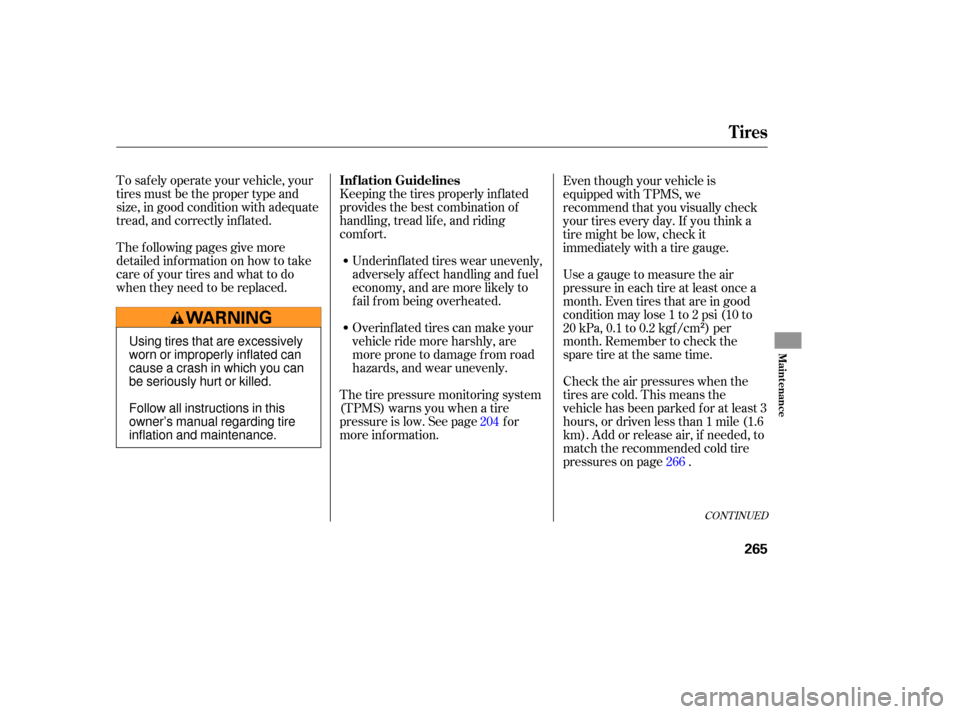2007 HONDA RIDGELINE flat tire
[x] Cancel search: flat tirePage 72 of 331

This indicator normally comes on for
a few seconds when you turn the
ignition switch to the ON (II)
position. If it comes on while driving, This
indicator normally comes on for
a few seconds when you turn the
ignition switch to the ON (II)
position.
it indicates that one or more of your
vehicl e’s tires are extremely low on
pressure.
If this happens, pull to the side of the
ro ad when it is safe, check which tire
has lost the pressure on the tire
pressure monitor, and determine the
cause. If it is because of a flat tire,
replace the flat tire with the compact
spare (see page ), and have the
flat tire repaired as soon as possible.
If two or more tires are underinflated,
call a professional towing service
(see page ). Refer to page
f or more inf ormation. If this indicator comes on and stays
on at any other time, or if it does not
come on when you turn the ignition
switch to the ON (II) position, there
is a problem with the TPMS. With
this indicator on, the low tire
pressure indicator and the tire
pressure monitor will not come on
when a tire loses pressure. Take the
vehicle to your dealer to have the
system checked.
This monitor normally comes on f or
a f ew seconds when you turn the
ignition switch to the ON (II)
position. While driving, the
appropriate tire indicator will come
on, along with the low tire pressure
indicator, if a tire is extremely
underinf lated or has suddenly lost
pressure. See
forwhattodoif this
indicator comes on.
274
296
204 Tire Pressure Monitoring
System (T PMS) Indicator
Low Tire Pressure
Indicator T ire Pressure Monitor
Low Tire Pressure
Indicator
Instrument Panel Indicators
68
Page 187 of 331

For example, an underinflated tire
causes more ‘‘rolling resistance,’’
which uses more fuel.
The build-up of snow or mud on
your vehicl e’s underside or on the
truck bed adds weight and rolling
resistan ce. Frequent cleaning
helps your fuel mileage and
reduces the chance of corrosion.
Drive moderately. Rapid
acceleration, abrupt cornering,
and hard braking use more fuel.
Always drive in the highest gear
possible. Try
to maintain a constant speed.
Everytimeyouslowdownand
speed up, your vehic le uses extra
fuel. Use cruise control when
appropriate.
Combine several short trips into
one.
The air conditioning puts an extra
load on the engine which makes it
usemorefuel.Usethefresh-air
ventilation when possible.
Always
maintain your vehicle
according to the maintenance
messages displayed on the
inf ormation display. See on page
.
241
Improving Fuel Economy
Owner’s
Maintenance Checks
Fuel Economy
Bef ore Driving
183
Page 209 of 331

Each wheel is equipped with a tire
pressure sensor mounted inside the
tire behind the valve stem. You must
use TPMS specific wheels. It is
recommended that you always have
your tires serviced by your dealer or
qualified technician.
The
appropriate tire indicator and
low tire pressu re indicator comes on
if a tire becomes significantly
underinflated. See
on page .
Driving
on a signifi cantly under-
inflated tire causes the tire to
ov erheat and can lead to tire failure.
Under-infl ation also reduces fuel
efficiency and tire tread life, and may
affect the vehicle’s handling and
stopping ability.
Al though your tire pressure is
monito red, each tire should be
checked monthly, including the
spare.
Set to the recommended inflation
pressure as specified on the vehicle
placard and in this owner’s manual
(see page ).
Check
the pressure with the tires
cold, after the vehic le has been
parked for at least 3 hours. This
indicator comes on and stays on
if there is a problem with the tire
pressure monitoring system.
If this happens, the system will shut
off and no longer monitor tire
pressures. Have the system checked
by your dealer as soon as possible.
If you have a flat tire, the low tire
pressu re and tire monitor indicators
will come on. Replace the indicated
flat tire with the compact spare tire
(see page ). Never use a puncture-repairing agent
in a f lat tire. If used, you will have to
replace the tire pressure sensor.
Havetheflattirerepairedbyyour
dealer as soon as possible. After you replace the flat tire with
thecompactsparetire,thelowtire
pressure indicator stays on. This is
normal; the system is not monitoring
the spare tire pressure. Manually
check the spare tire pressure to be
sure it is correct.
266 204
275
CONT INUED
Tire Pressure Monitoring
System (T PMS) Indicator Low Tire
Pressure Indicator T ire Pressure Monitor
Changing a T ire with T PMS
Tire Pressure Monitoring System (TPMS)
Driving
205
Page 222 of 331

Always use safety chains when you
tow a trailer. Make sure the chains
are secured to the trailer and hitch,
and that they cross under the tongue
and can catch the trailer if it
becomes unhitched. Leave enough
sl ack to allow the trailer to turn
co rners easily, but do not let the
ch ains drag on the ground.
This device is recommended if your
trailer tends to sway. Your trailer
maker can tell you what kind of sway
control you need and how to install it.
Many states and provinces require
special exterior mirrors when towing
a trailer. Even if they don’t, you
should install special mirrors if you
cannot clearly see behind you, or if
the trailer creates a blind spot. When
towing a trailer, we
recommend that you carry a full-size
spare wheel and tire for your vehicle
and trailer. See page for proper
tire size, page for how to store a
full size wheel and tire, and page
f or inf ormation on changing a
flat tire.
Remember to unhitch the trailer
bef ore changing a f lat. Ask your
trailer sales or rental agency where
and how to store the trailer’s spare
tire. 269
280
275
Saf et y Chains
Sway Cont rolTrailer Mirrors Spare Tires
Towing a Trailer
218
Page 269 of 331

To safely operate your vehicle, your
ti res must be the proper type and
size, in good condition with adequate
tread, and correctly inflated. Keeping
the tires properly inflated
provides the best combination of
handling, tread life, and riding
comfort.
The following pages give more
detailed information on how to take
care of your tires and what to do
when they need to be replaced. Underinflated
tires wear unevenly,
adversely affect handling and fuel
economy, and are more likely to
fail from being overheated.
Overinflated tires can make your
vehicleridemoreharshly,are
more prone to damage from road
hazards, and wear unevenly.
Thetirepressuremonitoringsystem
(TPMS) warns you when a tire
pressu re is low. See page for
more information. Even
though your vehicle is
equipped with TPMS, we
recommend that you visually check
your tires every day. If you think a
tire might be low, check it
immediately with a tire gauge.
Use a gauge to measure the air
pressure in each tire at least once a
month. Even tires that are in good
condition may lose 1 to 2 psi (10 to
20 kPa, 0.1 to 0.2 kgf/cm ) per
month. Remember to check the
sparetireatthesametime.
Check the air pressures when the
tires are cold. This means the
vehicle has been parked for at least 3
hours, or driven less than 1 mile (1.6
km). Add or release air, if needed, to
match the recommended cold tire
pressures on page .
204
266
CONT INUED
Inf lation Guidelines
Tires
Maint enance
265
Using tires that are excessively
worn or improperly inflated can
cause a crash in which you can
be seriously hurt or killed.
Follow all instructions in this
owner’s manual regarding tire
inflation and maintenance.
Page 270 of 331

Every time you check inflation, you
should also examine the tires for
damage, foreign objects, and wear.
Youshouldlookfor: Bumps or bulges in the tread or
side of the tire. Replace the tire if
youfindeitheroftheseconditions.
Cu ts, splits, or cracks in the side
of the tire. Replace the tire if you
can see fabric or cord.
Excessive tread wear.
If
you check air pressures when the
tires are hot [driven for several miles
(kilometers)], you will see readings 4
to6psi(30to40kPa,0.3 to0.4
kgf/cm ) higher than the cold
readings.Thisisnormal.Donotlet
air out to match the recommended
cold air pressure. The tire will be
underinf lated.
For additional inf ormation about
your tires, see page . For convenience, the recommended
tire sizes and cold tire pressures are
on a label on the driver’s doorjamb. The following chart shows the
recommended cold tire pressures f or
most normal and high-speed driving
conditions. Never use a puncture-repairing agent
in a f lat tire. If used, you will have to
replace the tire pressure sensor.
Havetheflattirerepairedbyyour
dealer as soon as possible.
Youshouldgetyourowntire
pressure gauge and use it whenever
you check your tire pressures. This
will make it easier f or you to tell if a
pressure loss is due to a tire problem
and not due to a variation between
gauges.
While tubeless tires have some
ability to self -seal if they are
punctured, you should look closely
for punctures if a tire starts losing
pressure. 306
Tire Size Cold Tire Pressure
Compact Spare Front/Rear:
Tires
Tire Inspection
Recommended Tire Pressures
266
P245/65R17 105S 32 psi (220 kPa , 2.2 kgf/cm
)
60 psi (420 kPa , 4.2 kgf/cm
)
T165/90R17 105M
Page 277 of 331

This section covers the more
common problems that motorists
experience with their vehicles. It
gives you inf ormation about how to
safely evaluate the problem and what
to do to correct it. If the problem has
stranded you on the side of the road,
you may be able to get going again.
If not, you will also f ind instructions
on getting your vehicle towed.......................
Compact Spare Tire .274
....................
Changing a Flat Tire .275
.............
If the Engine Won’t Start .283
................................
Jump Starting .284
..............
If the Engine Overheats .286
.........
Low Oil Pressure Indicator .288
..........
Charging System Indicator .288
.......
Malf unction Indicator Lamp .289
...............
Brake System Indicator .290
..............................................
Fuses .291
..............................
Fuse Locations .294
......................
Emergency Towing .296
..........
If Your Vehicle Gets Stuck .297
Taking Care of the Unexpected
T aking Care of t he Unexpect ed
273
Page 278 of 331

Use the compact spare tire as a
temporary replacement only. Get
your regular tire repaired or replaced,
and put it back on your vehicle as
soon as you can.
Check the inflation pressure of the
compact spare tire every time you
check the other tires. It should be
inflated to:
Follow these precautions: Do
not mount snow chains on a
compact spare.
Do not use the compact spare tire
if you are towing a trailer.
Do not use your compact spare
tire on another vehicle unless it is
thesamemakeandmodel.
Replace the tire when you can see
the tread wear indica tor bars. The
replacement should be the same size
and design tire, mounted on the
same wheel. The spare tire is not
designed to be mounted on a regular
wheel, and the spare wheel is not
designed for mounting a regular tire.
Never
exceed 50 mph (80 km/h).
This tire gives a harsher ride and
less traction on some road
surf aces. Use greater caution
while driving. Driving with the compact spare
tiremayactivatetheTPMS(see
page ). The TPMS does not
monitor compact spare tire
pressure.
205
Compact Spare Tire
274
INDICATOR LOCATION MARK
TREAD WEAR INDICATOR BAR
60 psi (420 kPa , 4.2 kgf/cm)